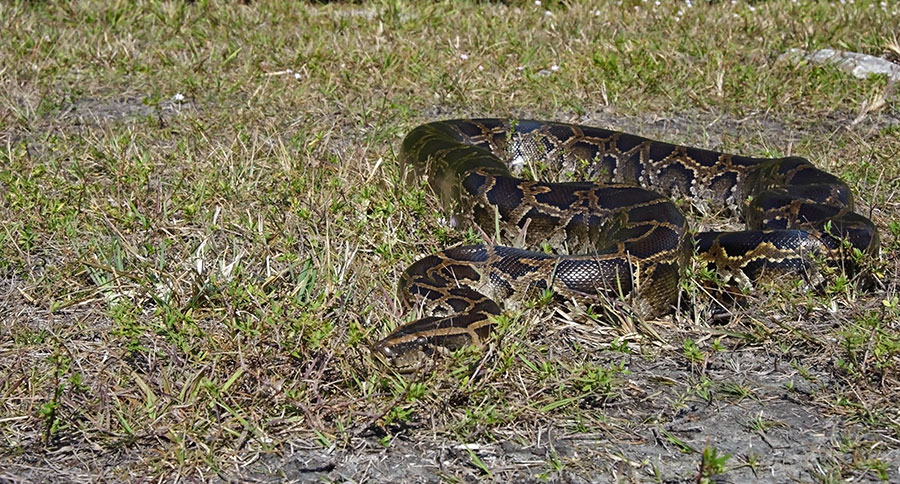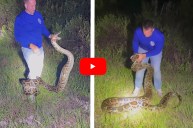We're getting to the bottom of the python invasion in Florida.
The Burmese python invasion started in the Sunshine State sometime in the 1980s, and it hasn't been pretty. Unfortunately, the venerable and iconic Florida Everglades have been overrun by one of the most damaging invasive species the region has ever seen.
These snakes can grow to massive sizes and squeeze the life out of an alligator. After their unauthorized introduction, pythons are doing a real number on South Florida's native small mammal population.
Since these highly invasive reptiles have basically begun to eat their way through the Everglades, the local Florida wildlife agency has introduced the Python Elimination Program. The program hires people to hunt the swamps for snakes, serving as "python removal agents." They are generally paid a minimum wage, but can earn additional money per foot of snake, which can add up to hundreds of dollars per serpent.
However, the Everglades are roughly twice the size of Rhode Island with only a couple of bisecting roads, meaning it can be a daunting task to hunt them. Add to that the fact that they have no natural predators in the area, and you have the making of a nightmare for Floridians.
Here's the lowdown on the situation, and what's being done to try and reverse it.
The Python
The Burmese python, or Python bivitattus, is a carnivorous constrictor from Asia that can live in the wild for up to 20 years or more. These snakes can also get huge; they'll stretch 15-25 feet long and weigh up to 200 pounds or more on the top end of the spectrum.
While they are mainly ambush hunting ground dwellers, the young are adept at climbing. However as National Geographic notes, "As they mature and their size and weight make tree climbing unwieldy, they transition to mainly ground-dwelling. They are also excellent swimmers, and can stay submerged for up to 30 minutes before surfacing for air."
Pythons have poor eyesight, so they use heat sensors based along their jaws along with chemical receptors in their tongues to get close to their prey and then squeeze the life out of it, hence the term constrictor.
Maybe the worst part of this alien predator: they generally lay eggs in clutches of up to 100.
How did pythons make it to Florida?
Even though this non-native species hails originally from Southeast Asia, they were a significant part of the booming exotic pet trade that emerged in South Florida.
Once the honeymoon of the exotic pets wore off, it is said that some irresponsible pet owners simply drove their snakes to the Everglades National Park and released them into infamy. And yet that may not be the single biggest reason for the tens of thousands of invasive Burmese pythons that now reside there—in 1992 after the devastation of hurricane Andrew, during which a python breeding facility was destroyed, countless snakes were accidentally released into the nearby swamps and waterways.
According to CBS News, Hurricane Andrew made landfall south of Miami as a Category 5 hurricane, one of the most powerful ever to hit the United States.
With winds over 150 miles per hour, Andrew destroyed buildings, many of which were exotic wildlife facilities. One those held a breeding facility for Burmese pythons, and many of them were able to excape.
Though it is now illegal to own them in Florida, the law was put into place in 2010, well after the populations of pythons in had taken hold in the wild.
The Consequences
The same CBS report stated that after Andrew fueled the Burmese python invasion of the Florida Everglades, populations of raccoons and opossums dropped by nearly 99 percent. In fact, multiple fox and rabbit species disappeared altogether.
According to the Smithsonian, a 2013 study fitted a group of marsh rabbits with radio transmitters and released them into python territory. They ultimately discovered that 77 percent of those rabbits were eaten by pythons.
The fact is, pythons seem to grow in numbers faster than hunters can kill or catch them, so the state has officially announced that it is open season on them as hunters on private land can now hunt them year round without a permit or even a hunting license.
Hunters hoping to get in on the action must first be approved for python extraction and eradication by the South Florida Water Management District's Python Elimination Program.
The Bottom Line
No one knows just exactly how many pythons could now be naturally living in the state of Florida, but they are on the move since one was found in southern Georgia back in 2012. The estimates range anywhere from 10,000 animals to 300,000 and counting, so taking 5,000 out of the area is just a drop in the bucket.
The History Channel quoted Daniel Simberloff, a biologist and ecologist at the University of Tennessee—Knoxville, who touched on why the snakes are thriving.
"The habitat of the Everglades—it's perfect," he said. "It's warm; they do really well in muddy, marshy habitats...and of course there's this huge food base that was totally unadapted to deal with them. There was nothing to keep them from doing very well."
Scientists are starting to get deadly serious about the issue by considering canine detection and even genetic warfare.
"(They could) put a gene in there that causes all the offspring of a male that carries the gene to be male," Siberloff said. "Or causes all the female offspring to die. And these driven genes could really knock back the population."
Even in a time where Americans can't seem to agree on much, between COVID-19 and the upcoming election season, there's a unanimous consensus in Florida: the python crisis must be addressed.
Looking for a little more or even hot lunch for your hunting blind? Follow my webpage, or on Facebook and Twitter.
NEXT: HOW TO KILL A RATTLESNAKE WITH YOUR BARE HANDS
WATCH





